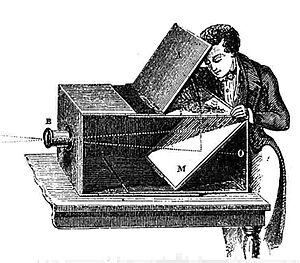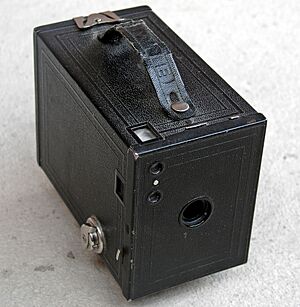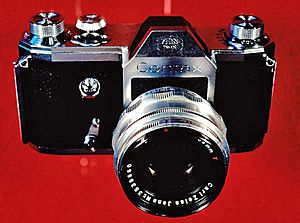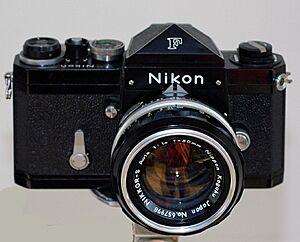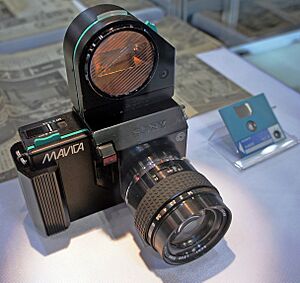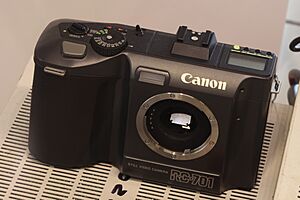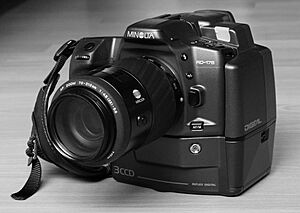History of the camera facts for kids
The history of the camera is a super interesting journey! Cameras started way before photography was even invented. They grew from simple "dark rooms" (called camera obscuras) and changed a lot over time. We went from early daguerreotypes and calotypes to film cameras, and now we have amazing digital cameras and even camera phones in our pockets!
Contents
What is a Camera Obscura?

The camera obscura is like the great-grandparent of modern cameras. Its name means "dark room" in Latin. It's a natural trick of light: if you have a dark room with a tiny hole, light from outside shines through that hole and projects an upside-down image of the outside world onto the opposite wall.
The first known explanation of this idea came from a Chinese philosopher named Mozi (around 470 to 391 BC). He figured out that the image was upside down because light travels in straight lines.
Around 1550, people started using lenses in these dark rooms to make the projected images clearer. This helped artists trace pictures. By the late 1600s, people made portable camera obscuras that looked like tents or boxes. These were popular tools for drawing.
The problem was, these early cameras couldn't save the pictures. Artists had to trace them by hand. The first cameras were huge, big enough for people to sit inside! But over time, they got smaller. By the 1800s, there were small box camera obscuras that could be used for photography.
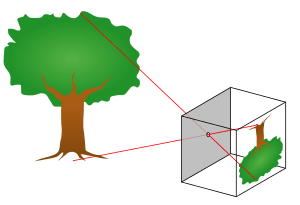
An Arab scientist named Ibn al-Haytham (around 965–1040 AD) also did important work on the camera obscura. He experimented with light in a dark room and is often given credit for inventing the pinhole camera. He was the first to really explain how the camera obscura worked using geometry. His ideas helped inspire many famous thinkers like Leonardo da Vinci and Johannes Kepler.
How Did Early Photographic Cameras Work?
For hundreds of years, people knew that some materials, like silver salts, would turn dark when exposed to sunlight. In 1727, a German scientist named Johann Heinrich Schulze proved that it was light, not heat or air, that made these salts change color. Later, in 1777, a Swedish chemist named Carl Wilhelm Scheele found that silver chloride was especially good at this.
The first person to try using this idea to create images was Thomas Wedgwood. He put things like leaves on ceramic pots coated with silver nitrate and exposed them to light. He got images, but they didn't last because he couldn't "fix" them (make them permanent).
The First Permanent Photographs
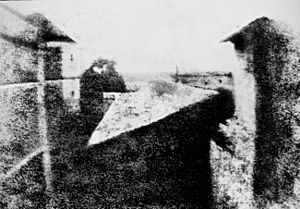
The very first permanent photograph taken with a camera was made in 1826 by Joseph Nicéphore Niépce. He used a wooden box camera and exposed a pewter plate coated with bitumen for about 8 hours! He called his method "heliography."
Niépce partnered with Louis-Jacques-Mandé Daguerre to make the process better. After Niépce died in 1833, Daguerre kept working. By 1837, he created a much clearer and sharper image using silver iodide and mercury vapor. He also found a way to "fix" the images using salt water, making them permanent. He called his invention the Daguerreotype. The French government bought his process and shared it with the world in 1839.
The Calotype and Negatives
Around the same time, in the 1830s, an English scientist named William Henry Fox Talbot also invented a way to capture camera images using silver salts. In 1839, he published the first description of photography. Within two years, Talbot developed a two-step process called calotypes.
The calotype process was super important because it was the first to use a negative. This means that the light and dark parts of the image are reversed on the negative. From this negative, you could make many positive prints. This negative/positive process is the basis for how most photography worked for a long time! Daguerreotypes, on the other hand, only made one direct positive print, so you couldn't easily make copies.
Early Commercial Cameras
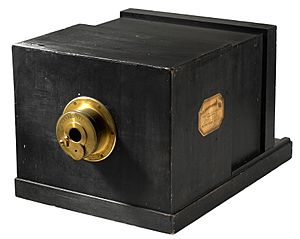
The first camera made for sale was a daguerreotype camera built by Alphonse Giroux in 1839. It was a "double-box" design: one box slid inside another to focus the image. It cost a lot of money back then! Early daguerreotype cameras needed very long exposure times, from 5 to 30 minutes.
Soon, other camera makers improved on this. Some cameras had faster lenses, which cut down exposure times to just 3 minutes. Others had ways to change how much light entered the camera, similar to modern f-stops. In Germany, Voigtländer designed a metal camera with a special lens by Joseph Petzval. This Petzval lens was much faster than others, making it great for taking portraits.
In America, different types of daguerreotype cameras became popular. Some used sliding boxes, while others, like the Lewis-type introduced in 1851, used bellows for focusing. Bellows are like a flexible accordion that lets you move the lens or plate closer or further away to get a clear picture.
Over time, exposure times got much shorter, down to just a few seconds, thanks to better chemicals and lenses. Plate sizes for daguerreotypes also became standard, from small "ninth plates" to large "whole plates."
Wet Plates and Dry Plates
In the 1850s, the collodion wet plate process became popular. Photographers had to coat thin glass or iron plates with chemicals right before taking a picture, and the plate had to stay wet during exposure. This meant photographers often needed a portable darkroom with them!
Later, in 1871, Richard Leach Maddox invented the gelatin dry plate. This was a huge step because photographers no longer needed to prepare plates on the spot. They could buy pre-made dry plates and take pictures much more easily. In 1878, it was discovered that heating the gelatin made the plates even more sensitive to light. This made "instant" snapshots possible for the first time! You didn't always need a tripod anymore; you could hold the camera in your hand.
This led to many new camera designs, including simple box cameras and even "detective cameras" hidden inside things like pocket watches. As cameras became faster, mechanical shutters were invented to control the exact amount of time the light hit the plate.
The Invention of Photographic Film
The use of photographic film was a game-changer, pioneered by George Eastman. He started making paper film in 1885, then switched to celluloid film in 1889.
His first camera, called the "Kodak," was sold in 1888. It was a simple box camera with a fixed lens and one shutter speed. It was affordable and came pre-loaded with film for 100 pictures. When you finished the roll, you sent the whole camera back to the factory for processing and reloading! By the end of the 1800s, Eastman had many different camera models.
In 1900, Eastman made photography even more accessible with the Brownie camera. It was very simple and cheap, introducing the idea of the "snapshot" to everyone. The Brownie was incredibly popular and was sold for many decades.
Film also made it possible to capture moving pictures, leading to the birth of the movie camera and the film industry!
The Rise of 35mm Cameras
Between 1905 and 1913, some manufacturers started using 35mm film for still photos. This was the same film used for movies.
Oskar Barnack at Leitz (a German company) wanted to build a small camera that could take high-quality pictures that could be enlarged. He built his first 35mm camera prototype around 1913. After World War I, Leitz released the Leica I in 1925. It was very popular and made 35mm the standard for high-quality, compact cameras.
Kodak joined the 35mm market with the Retina I in 1934. This camera introduced the 135 film cartridge, which is still used in 35mm cameras today. While 35mm cameras were still a bit expensive for most people, the introduction of the very popular Argus C3 in 1939 changed that. By the time the C3 stopped being made in 1966, 35mm film ruled the market.
Japanese camera companies like Canon also started making 35mm cameras in the 1930s. After the Korean War, American soldiers brought Japanese cameras back home, and they quickly became popular in the West.
TLRs and SLRs: Seeing Through the Lens
The first useful TLR (Twin-Lens Reflex) was the Rolleiflex in 1928. TLRs have two lenses: one for taking the picture and one for you to look through to compose your shot. Before this, reflex cameras were too big, but the Rolleiflex was compact and became very popular.
A similar change happened with SLR (Single-Lens Reflex) cameras. The Ihagee Exakta in 1933 was a compact SLR. SLRs use mirrors to let you see directly through the same lens that takes the picture. This means what you see in the viewfinder is exactly what the camera sees.
After World War II, 35mm SLRs became very popular, and many new models with cool features came out. A big improvement was the eye-level viewfinder, which first appeared in 1947. In 1948, the Contax S was the first camera to use a pentaprism, which made the image in the viewfinder appear correctly (not reversed). The Hasselblad 1600F also set the standard for medium format SLRs for decades.
In 1952, the Asahi Optical Company (known for Pentax cameras) introduced the first Japanese 35mm SLR, the Asahiflex. Other Japanese companies like Canon and Nikon also entered the SLR market. The Nikon F (1959) was especially important because it was a "system camera" with many interchangeable parts and accessories. It helped establish Nikon's reputation for professional-quality cameras.
Instant Cameras
While traditional cameras were getting better, a completely new type of camera appeared in 1949: the Polaroid Model 95. This was the world's first successful instant-picture camera! It was called a Land Camera after its inventor, Edwin Land. These cameras were a huge hit because they could print a picture right after you took it.
Automation in Cameras
In 1938, the Super Kodak Six-20 was the first camera with automatic exposure. This meant the camera could figure out how much light was needed for a good picture all by itself. However, it was very expensive. By the 1960s, electronic parts became cheaper, and cameras with light meters and automatic exposure systems became common.
In 1960, the German Mec 16 SB was the first camera to put the light meter behind the lens. This gave much more accurate readings. This "through-the-lens" (TTL) metering became a common feature on SLRs.
The Digital Camera Revolution
Digital cameras are different from older cameras because they don't use film. Instead, they capture and save photos on digital memory cards or internal storage. Because they are cheaper to use (no film or developing costs), they have mostly replaced film cameras. Today, digital cameras are everywhere, especially in mobile phones, and they often have Wi-Fi or Bluetooth to share photos easily.
How Digital Imaging Works
The first image sensor made of semiconductors was the CCD (Charge-Coupled Device), invented in 1969. This technology was later used in early digital video cameras for TV.
Another important sensor, the CMOS (Complementary Metal-Oxide-Semiconductor) active-pixel sensor, was developed in 1993. CMOS sensors helped make digital cameras much cheaper and smaller, which was key for camera phones.
Early Digital Camera Ideas
The idea of turning images into digital information came before actual digital cameras. Early spy satellites, for example, would develop film in space and then scan it electronically to send the images back to Earth. This was very complex. Scientists wanted a way to capture images electronically without film.
In 1975, Steven Sasson, an engineer at Eastman Kodak, built the first self-contained digital camera prototype. It weighed 8 pounds, recorded black-and-white images to a cassette tape, and had a very low resolution (0.01 megapixels). It took 23 seconds to capture one image! This was just an experiment, not meant for sale.
Analog Electronic Cameras
Handheld electronic cameras that recorded images like video appeared in 1981 with the Sony Mavica. This camera recorded TV-like signals onto a small "video floppy" disk. It was essentially a video camera that could record single frames.
The first analog electronic camera sold to the public might have been the Casio VS-101 in 1987. These early electronic cameras were very expensive (tens of thousands of dollars!) and didn't produce images as good as film. They were mostly used by news media because they could send images over phone lines quickly, which was useful during events like the 1989 Tiananmen Square protests.
The First True Digital Cameras
By the late 1970s, the technology for real commercial digital cameras was ready. The first truly portable digital camera that saved images as a computer file was probably the Fuji DS-1P in 1988, which used a memory card. However, it was never sold to the public.
The first portable digital camera actually sold commercially was the Dycam Model 1, shipped in November 1990. It was black-and-white, low resolution, and cost almost $1,000. It connected directly to a computer to download pictures.
Digital SLRs (DSLRs)
In 1991, Kodak released the Kodak DCS (Kodak Digital Camera System). This was the first commercially available Digital SLR (DSLR). It used a 1.3-megapixel sensor and was very expensive, costing $13,000.
The development of JPEG and MPEG standards in 1988 helped digital cameras by allowing images and videos to be compressed, making them easier to store. The first consumer camera with an LCD screen on the back was the Casio QV-10 in 1995.
In 1999, Nikon introduced the Nikon D1. This was a 2.74-megapixel camera that was the first digital SLR designed from scratch by a major camera maker. It cost under $6,000, making it more affordable for professional photographers and serious hobbyists. It also used Nikon's existing lenses, which was a big plus for film photographers.
Since 2003, digital cameras have sold more than film cameras. Kodak, once a giant in film photography, even stopped selling film cameras in many parts of the world in 2004 and later filed for bankruptcy in 2012, showing how much the industry had changed.
Camera Phones
The first commercial camera phone was the Kyocera Visual Phone VP-210, released in Japan in May 1999. It had a small front-facing camera and could store up to 20 pictures, which could be sent by email.
The Samsung SCH-V200, released in South Korea in June 2000, also had a built-in camera. However, you needed to connect it to a computer to get the photos. The first camera phone that could instantly send pictures over the cell phone network was the J-SH04, a Sharp J-Phone model sold in Japan in November 2000.
The development of cheaper CMOS sensors helped camera phones become so popular. Today, almost all Smartphones have high-resolution digital cameras, making photography a part of everyday life for billions of people!
Images for kids


